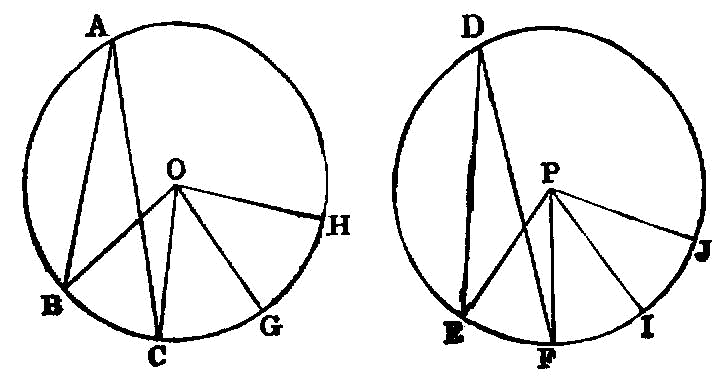Proposition 6.33

In equal circles angles have the same ratio as the circumferences on which they stand, whether they stand at the centres or at the circumferences.
Let ABC, DEF be equal circles, and let the angles BGC, EHF be angles at their centres G, H, and the angles BAC, EDF angles at the circumferences; I say that, as the circumference BC is to the circumference EF, so is the angle BGC to the angle EHF, and the angle BAC to the angle EDF.
For let any number of consecutive circumferences CK, KL be made equal to the circumference BC, and any number of consecutive circumferences FM, MN equal to the circumference EF; and let GK, GL, HM, HN be joined.
Then, since the circumferences BC, CK, KL are equal to one another, the angles BGC, CGK, KGL are also equal to one another; [III. 27]
For the same reason also, whatever multiple the circumference NE is of EF, that multiple also is the angle NHE of the angle EHF.
If then the circumference BL is equal to the circumference EN, the angle BGL is also equal to the angle EHN; [III. 27] if the circumference BL is greater than the circumference EN, the angle BGL is also greater than the angle EHN; and, if less, less.
There being then four magnitudes, two circumferences BC, EF, and two angles BGC, EHF, there have been taken, of the circumference BC and the angle BGC equimultiples, namely the circumference BL and the angle BGL, and of the circumference EF and the angle EHF equimultiples, namely the circumference EN and the angle EHN.
And it has been proved that, if the circumference BL is in excess of the circumference EN, the angle BGL is also in excess of the angle EHN; if equal, equal; and if less, less.
Therefore, as the circumference BC is to EF, so is the angle BGC to the angle EHF. [V. Def. 5]
But, as the angle BGC is to the angle EHF, so is the angle BAC to the angle EDF; for they are doubles respectively.
Therefore also, as the circumference BC is to the circumference EF, so is the angle BGC to the angle EHF, and the angle BAC to the angle EDF.
Therefore etc. Q. E. D.
